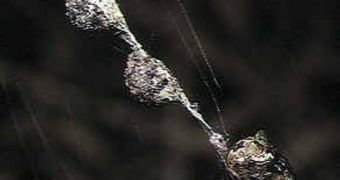A species of spiders has recently amazed researchers, when it proved that it could construct a life-size imitation of itself, so as to confuse predators. To their eyes, the thing at the center of the web looks exactly like the spider they are chasing after, but they're in for a disappointment. The actual Cyclosa mulmeinensis is actually a good distance away, safe, and ready to weave another replica of itself somewhere else. The impression is so good, that only upon closer inspection the scam is revealed.
Researchers from Taiwan discovered that the spider used a cunning strategy to avoid being attacked by such predators as wasps, when it put together pellets of its victims' carcasses and egg sack in such a configuration that it mimicked the size and conformation of its own body exactly. This is the first animal in the world to ever be discovered as having this ability, namely to create believable imitations of itself.
Experts Ling Tseng and I-Min Tso, both biologists at the Tunghai University, in Taichung, Taiwan, discovered that the spider might be using these ornaments on its web not to avoid being attacked altogether, but to redirect a sufficient number of attacks towards the imitations. This would leave it sufficient time to ascape and avoid the wasps' deadly sting. In previous researches, it had been proven that having ornaments on the webs actually attracted more predators, but biologists hypothesize that the strategy employed by spiders is similar to that used by animals such as butterflies and lizards.
These two species use diversion to escape. While the butterfly has evolved to display “eyes” on its wings, the lizard uses its bright-colored tail to draw the attention of predators, and then sheds it in case something catches it. While, generally speaking, it's not a good idea to attract animals that want to kill you in the first place, the strategy often works, and the lizards escape. The same works for the spider as well. While, at first glance, it may seem a bit dumb to elicit more wasp attacks by building shiny ornaments on webs, the benefits of the strategy become visible when observing that almost all attacks fail to hit the C. mulmeinensis.
Conversely, for other spider species that don't place anything on their webs, attacks are rarer, but they most often succeed, and the spiders succumb to wasps, for instance, because there is nothing around to distract the attack. “We predicted that spiders with prey carcass decorations on webs should receive fewer wasp attacks because spiders should be well camouflaged by such objects. To our surprise, spiders on decorated webs received far more attacks than those on undecorated webs,” Tso explained, quoted by the BBC News.
“Our results show that this vulnerable spider protects itself from predator attacks by constructing decoys that increase the conspicuousness of the web, and resemble its own appearance in size and color. When both spiders and web decorations are present on the same web, they look like a string of nearly identical oval objects to the predators. I don't know of any animal that actively builds a decoy of itself. Our study seems to be the first to empirically demonstrate the function of animal-made decoys,” the researchers wrote in the latest issue of the journal Animal Behavior.
“Decorations built by Cyclosa spiders function as a conspicuous anti-predator device instead of a camouflaging device. The benefit of successful escape from predator attack seems to outweigh the cost of increased detection. I think that the functions of web decorations might be very diverse and differ from taxa to taxa. Different spiders seem to decorate their webs for different reasons,” Tso concluded.

 14 DAY TRIAL //
14 DAY TRIAL //